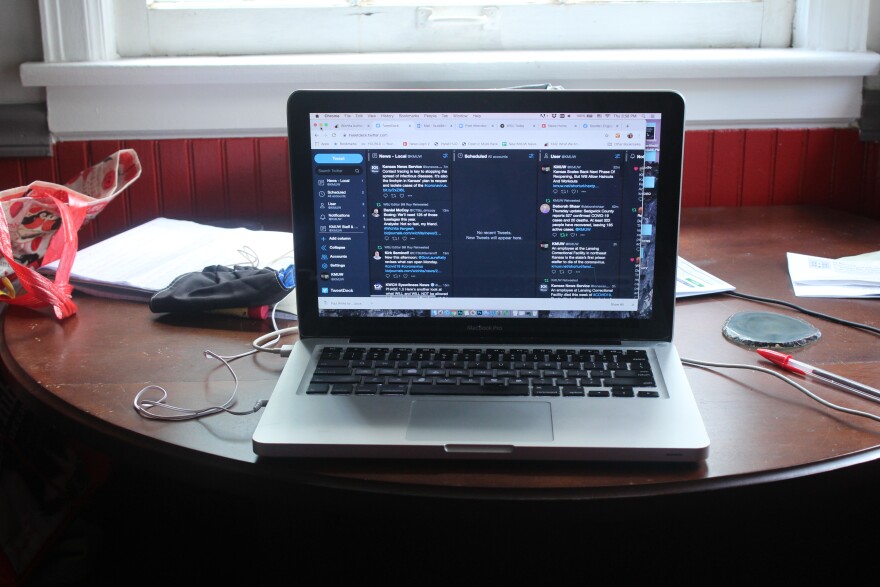One day you’re working from an office in downtown Wichita, the next you’re conducting business out of the spare bedroom downstairs.
Among the many changes the pandemic has caused, perhaps none has impacted people more than having to work from home.
Wichita psychologist Paul White is a speaker and international leadership trainer who — according to his website — “makes work relationships work.”
He conducted a recent study of 50 workers who are now working remotely in order to see what challenges they were facing and whether those were causing anxiety and stress.
White talked with Tom Shine and The Range about his findings, and the many positive factors remote workers mentioned.
The interview was edited for length and clarity.
Not surprisingly, a lot of the people that you studied say they like working from home. But your study found that they really, really like working from home, don't they?
That was one of the surprises. I figured, and we sort of anticipated, that there would be aspects that people liked about working from home. But the intensity and sort of breadth of it was somewhat surprising in that over 50% said, "Man, I really, really liked not having to commute and saves me an hour to two hours a day."
[There’s also] the issue of getting fully dressed for work versus maybe partially dressed for video conference or just dressing casually. And the amount of time that that added to their lives, both in terms of relating and being able to spend time with family members or their pets or friends. And then also just personal habits of exercising and cleaning things up around the house. So it was a huge theme that we heard from a lot of people.
Which will then lead you to believe … that after the pandemic ends or when it kind of gets back to normal, I'm guessing that remote work is not going to go away?

Yeah, I don't think so. Not in the sense of the way it was before. I mean, it's been growing in the past 10 years anyway. There's different studies that have been done previously. It showed that at least 50% of the workforce could work partially from home.
But now, I think both the combination of people's experience along with … I saw some other research cited that productivity really hasn't diminished in a lot of cases. And so you can make the case that people could work at least part-time from home, maybe one or two days a week or a day every other week. It will lead to some interesting challenges in the workplace. But I think we're going to be moving that way.
Wichita is a big manufacturing city, obviously. Is it as easy for our workforce to work remotely as some comparable cities in the Midwest?
I think not. I think the manufacturing aspect … [plus] Wichita is also sort of a hub of medical services, which obviously, I mean you have telemedicine, but at some level you've got to get diagnostic tests done or procedures done. And so those individuals providing those aren't going to have the option to work from home as much.
And so … part of the dilemma is that we're going to have different kinds of workforces that the options there are more or less. I mean, in manufacturing for example, do management and certain departments, you know, accounting, IT … work from home while the rest of the company works on site? There'll be some interesting dynamics around that.
Going back to your study for a minute here, you say that employees who were working remotely or working from home [report] that checking in with colleagues via video conference to talk about non-work topics and sharing funny texts or videos was helpful. Which means that cat videos actually have a purpose now, don't they?
Well, they do for cat people. I happen to be a dog person in my team. They actually posted some cat pictures from our team, and I said, "Hey, we've got to give this dog lover some equal time."
But that is true. There is now a research-based purpose for cat videos.
Talk a little bit more about why that time's important.
What we actually found two years ago when we compared remote employees versus onsite employees and how they like to be shown appreciation or encouraged those themes came up then. … They liked to connect by video versus just by phone or email or text because there is that sort of facial component that's important.
But equally important, and probably even more so, is the issue of being proactive. Because in remote work relationships, there's not those spontaneous interactions that occur either walking by somebody's office or seeing them in the break room or coming in in the morning. And so there's not those just serendipitous encounters where you get to chat about the day and the evening and whatever's going on. And so unless you plan for those and structure those, they really don't happen.
What have you learned about employees in general from the pandemic?
One of the things that we found that was pleasantly surprising to me was how positively people were really striving to respond. … We asked a bunch of feeling questions and had them rate themselves. And the level of happiness, contentment, productivity were relatively high. Loneliness and hopelessness especially was quite low, and that they are working at doing the right things.
To be honest, again, comparing the people that were faring fairly well with regards to managing anxiety and stress, they were engaging actively in activities rather than just sort of passively waiting for things to happen to them or for others to reach out.




